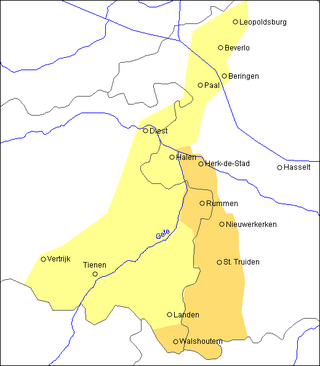Top Qs
Timeline
Chat
Perspective
Getelands
Brabantian dialect of Belgium From Wikipedia, the free encyclopedia
Remove ads
Getelands (Dutch pronunciation: [ˈɣeːtəlɑnts], Limburgish: Getelandjs [ˈɣeːtəlɑntʃs])[tone?] or West Getelands (Dutch: Westgetelands [ʋɛstˈxeːtəlɑnts], Limburgish: Wesgetelandjs [wæsˈxeːtəlɑntʃs])[tone?] is a South Brabantian dialect spoken in the eastern part of Flemish Brabant as well as the western part of Limburg in Belgium. It is a transitional dialect between South Brabantian and West Limburgish.
This article relies largely or entirely on a single source. (May 2021) |

The dialect is named after the river Gete. It is an endangered language.
Remove ads
Characteristics
The first person singular pronoun is typically the Limburgish ich, instead of Brabantian/Standard Dutch ik. The diminutive forms are formed as in Limburgish, using the umlaut. In Truierlands (sometimes called East Getelands), the plural is also formed by using the umlaut (pot /pɔt/ vs. pöt /pœt/), in contrast to Getelands plurals formed the Standard Dutch way (pot /pɒt/ vs. potte /ˈpɒtə/). Both dialects share the lack of pitch accent found in most varieties of Limburgish.
Word accent in the Orsmaal-Gussenhoven dialect shows phonetic features of accent 2 (the dragging tone) of the neighboring West Limburgish dialects.[1]
Remove ads
Phonology
Summarize
Perspective
This section shows the phonology of the Orsmaal-Gussenhoven dialect, which is spoken in the Linter municipality. The dialect of Melkwezer has a similar phonology, except for the fact that the diphthong /uɪ/ is realized with a mid onset: [ɔɪ].[2]

- /ʒ/ is restricted to word-initial position, and occurs only in loanwords from French. It tends to either devoice to [ʃ] or be affricated to [dʒ].[5]
- The exact place of articulation of /x, ɣ/ varies:
- /ɦ/ may be dropped by some speakers.[5]
- /r/ has a few possible realizations, none of which are uvular. This stands in contrast to most varieties of Limburgish, where /r/ is a uvular trill or fricative.
- Apical trill [r] or an apical fricative [ɹ̝] before a stressed vowel in word-initial syllables.[5]
- Intervocalically and in the onset after a consonant, it may be a tap [ɾ].[5]
- Word-final /r/ is highly variable; the most frequent variants are an apical fricative trill [r̝], an apical fricative [ɹ̝] and an apical non-sibilant affricate [dɹ̝]. The last two variants tend to be voiceless ([ɹ̝̊, tɹ̝̊]) in pre-pausal position.[5]
- The sequence /ər/ can be vocalized to [ɐ] or [ə].[6]

- Peters gives six more diphthongs, which are [eɪ, øʏ, əʊ, ɛɪ, œʏ, ɔʊ].[8] He gives no evidence for their phonemic status. As Brabantian dialects are known for both diphthongizing /eː, øː, oː/ and especially monophthongizing /ɛɪ, œʏ, ɔʊ/, the distinction between the closing diphthongs and the monophthongs is ignored elsewhere in the article, with ⟨eː, øː, oː, ɛː, œː, ɒː⟩ being used as cover symbols for both.
- The open central vowels are phonologically back in that they trigger the velar allophones of /x/ and /ɣ/.
- Among the long rounded vowels, /yː, uː, ɒː/ before /t, d/ within the same syllable vary between monophthongs [yː, uː, ɒː] and centering diphthongs [yə, uə, ɒə], which often are disyllabic [ʏy.ə, ʊu.ə, ɒʊ.ə] (with the first portion realized as a closing diphthong). At least in the case of [yə] and [uə], the tongue movement may be so slight that they are sometimes better described as lip-diphthongs [yi, uɯ]. In the same environment, /øː/ can be disyllabic [øʏ.ə].[9] For the sake of simplicity, those allophones are transcribed [yə, uə, ɒə, øə] in phonetic transcription.
- There are two additional short tense vowels [y] and [o], which are tenser (higher and perhaps also more rounded) than the native short /ʏ, ʊ/ (with the latter being [o̞] phonetically). They appear only in a few French loanwords. Their status as phonemes separate from the long tense /yː/ and /oː/ is unclear; Peters treats them as marginal phonemes.[9]
- /ɔə/ occurs only before alveolar consonants. Phonetically, it varies between [ɔə ~ ɔʊ.ə ~ ɔʌ].[9]
- Stressed short vowels cannot occur in open syllables. Exceptions to this rule are high-frequency words like wa /wa/ 'what' and loanwords from French.[9]
Remove ads
References
Bibliography
Wikiwand - on
Seamless Wikipedia browsing. On steroids.
Remove ads
